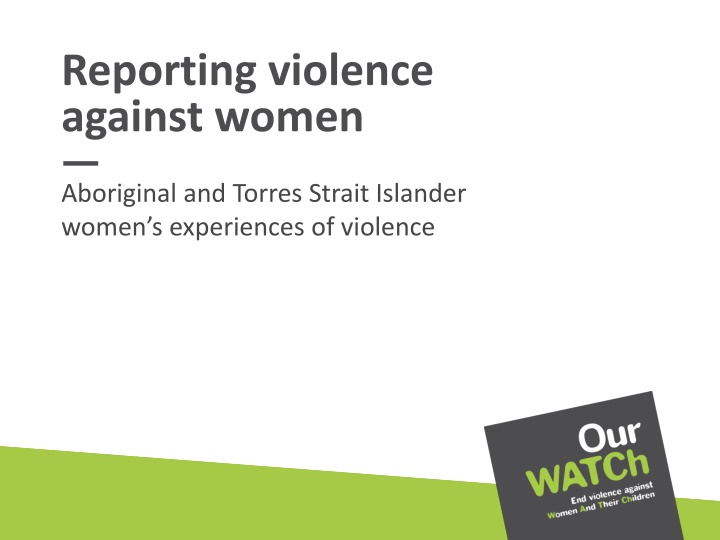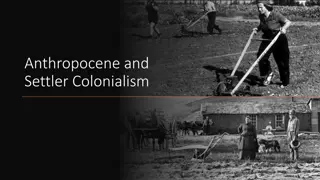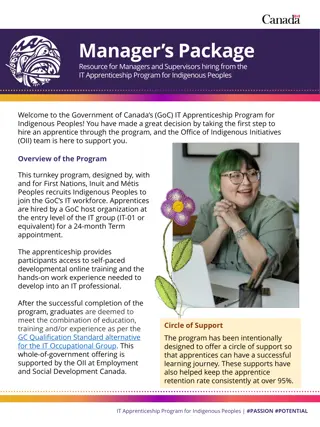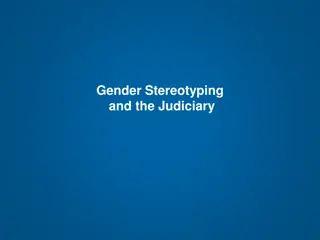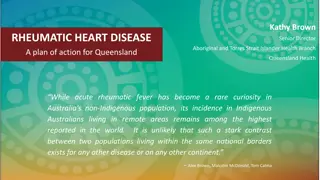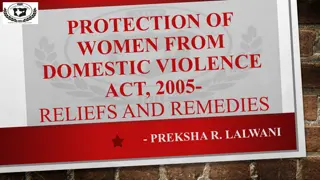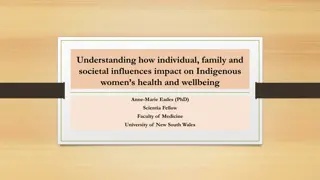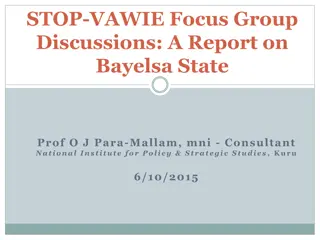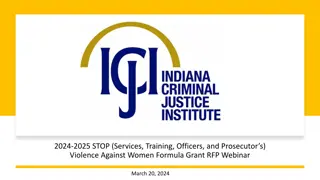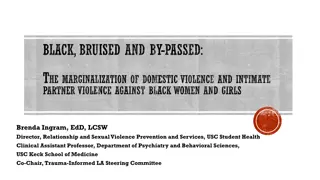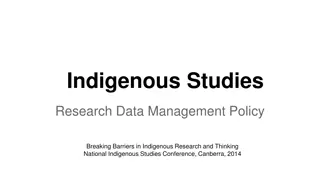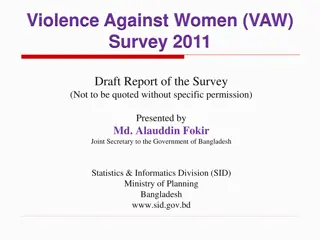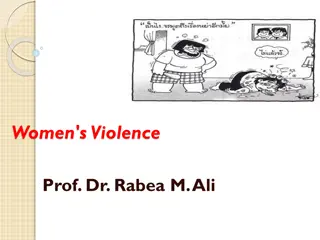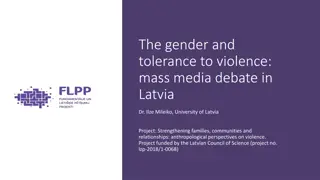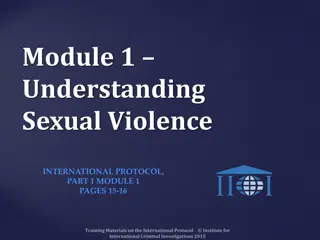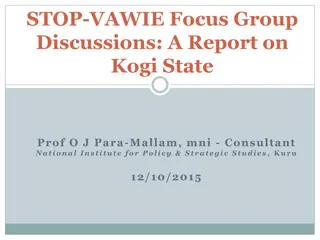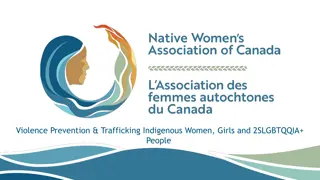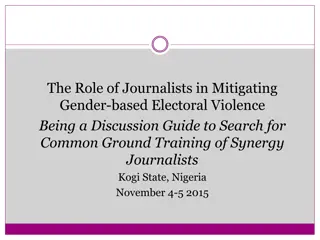Reporting Violence Against Indigenous Women
Profound impact of violence on Aboriginal and Torres Strait Islander women. Understand the cultural context, challenges in reporting, and guidelines for respectful journalism. Learn how to listen to and amplify their voices."
Uploaded on Mar 15, 2025 | 0 Views
Download Presentation

Please find below an Image/Link to download the presentation.
The content on the website is provided AS IS for your information and personal use only. It may not be sold, licensed, or shared on other websites without obtaining consent from the author.If you encounter any issues during the download, it is possible that the publisher has removed the file from their server.
You are allowed to download the files provided on this website for personal or commercial use, subject to the condition that they are used lawfully. All files are the property of their respective owners.
The content on the website is provided AS IS for your information and personal use only. It may not be sold, licensed, or shared on other websites without obtaining consent from the author.
E N D
Presentation Transcript
Reporting violence against women Aboriginal and Torres Strait Islander women s experiences of violence
We must do our job Violence against Aboriginal and Torres Strait Islander women is an important news story, and reporting it is part of our job as journalists. We should not shy away because of our own ignorance or lack of confidence. However: o We must be aware of our own cultural biases and prejudices o For most of us, there are extra layers of sensitivities and difficulties to negotiate if we are to do a good, constructive job
Just about every woman has her own story; we just need to listen. It is a sad truth that many Aboriginal and Torres Strait Islander women continue to be silenced by families, communities and systems. It is a sad truth that Aboriginal and Torres Strait Islander women and their cultural needs continue to be invisible to policy and lawmakers. It is a sad truth that many Aboriginal and Torres Strait Islander women get poor responses from the very system that is meant to protect them. Antoinette Braybrook CEO of the Aboriginal Family Violence Prevention and Legal Service
Context Family violence in Aboriginal and Torres Strait Islander communities occurs in the context of violent colonisation, dispossession, denial of culture, a breakdown of traditional kinship systems and the forced removal of children from their families Relatedly, many Aboriginal and Torres Strait Islander people live with enormous socio-economic disadvantage Family violence is not an aspect of traditional Indigenous cultures: be sure not to suggest that culture or ethnicity explains violence
Guidelines Getting information Take the time to learn the protocols of your local Aboriginal and Torres Strait Islander communities Develop a range of contacts in local Aboriginal and Torres Strait Islander communities rather than identifying one person as a spokesperson on all issues Victims may be at greater risk in small and isolated communities Don't be afraid to admit your own ignorance. Ask for suggestions on where to go, and who to talk to
Guidelines Getting information Do not take refusal to speak as hostility. There may be many reasons that people are reluctant to talk. Ask for alternatives Be patient: it may take longer to interview Indigenous people Don't be embarrassed by silence in interviews Be aware that in some Indigenous cultures, staring is rude Ask about cultural differences when reporting grief. In some Indigenous communities, the name or image of a recently deceased person should not be used. Seek the permission of the deceased s family
Guidelines Presenting the story Remember that although Aboriginal and Torres Strait Islander people are more likely to be victims of violence, the perpetrator is not always another Aboriginal and Torres Strait Islander Not every story about violence against Aboriginal and Torres Strait Islander women is about indigeneity Consider giving some cultural context and the history of the community involved When looking at social problems consider presenting solutions and active responses from community members
Examples 9
Resources and Help Services for Journalists and Students DART Self-care resources available at http://dartcenter.org/topic/self-care Please seek out your University Counselling Services Other Services These organisations offer 24/7 telephone support and counselling services, and online chat, for specific groups and for people in specific situations. 1800 RESPECT - The national sexual assault, domestic and family violence counselling service. 24/7 phone and online services. - 1800 737 732 KIDS HELPLINE - Kids Helpline is a counselling service for Australian children and young people aged between 5 and 25 years. 24/7 phone and online services - 1800 55 1800 MENS LINE - Professional support and information service for Australian men. 24/6 phone and online services. - 1300 78 99 78 MEN S REFERRAL SERVICE (MRS) - MRS provides anonymous and confidential telephone counselling, information and referrals to men to help them take action to stop using violence and controlling behaviour. - 1300 766 491 NAPCAN - Go to the Urgent Help section of the National Association for Prevention of Child Abuse and Neglect (NAPCAN) website for contact details of agencies which assist with reporting child abuse and neglect.
References - - ABC (2015) Indigenous Content Guidelines https://edpols.abc.net.au/guidance/abc-indigenous-content/ ABC (2014) ABC Reconciliation Action Plan 2013-15: First report against the Plan, January-December 2013 , http://about.abc.net.au/wp- content/uploads/2014/08/ABC-RAP-Report-2013-2.pdf Bowden, T. (2015) ABC Online, I can t hide my scars : Woman who lost eye in hammer attack speaks out against domestic violence , 25 November, http://www.abc.net.au/news/2015-11-25/marlene-tighe-loses-eye-teeth-after-being-beaten-by-partner/6973972 Braybrook, A. (2015) Aboriginal Family Violence & Legal Service Victoria, The Long Walk Women s Luncheon keynote address , 16th October, http://www.fvpls.org/images/files/Long%20Walk%20Women's%20Luncheon%20AB%20speech.pdf Korff, J. (2015) Creative Spirits, Mainstream media coverage of Aboriginal issues , http://www.creativespirits.info/aboriginalculture/politics/media- coverage-of-aboriginal-issues#axzz3swOseRcy Gregory, K. (2015) ABC Online, Bagot Indigenous leader slams broadcast of Darwin domestic violence offender sentencing , 17 September, http://www.abc.net.au/news/2015-09-16/community-reacts-to-domestic-violence-sentencing-broadcast/6779842 Human Rights and Equal Opportunity Commission (1991), Racist Violence: Report of the National Inquiry into Racist Violence in Australia , https://www.humanrights.gov.au/sites/default/files/document/publication/NIRV.pdf McCallum, K., Meadows, M., Waller, L., Dunne Breen, M., Reid, H. (2012) The Media and Indigenous Policy: How media reporting and mediatized practice impact on Indigenous policy A preliminary report, Journalism & Communication Studies, University of Canberra. Our Watch (2014) Reporting on Family Violence in Aboriginal and Torres Strait Islander Communities , https://www.ourwatch.org.au/MediaLibraries/OurWatch/Images/ourwatch_reporting_on_a-ts_family_violence_aa_v1.pdf Our Watch, (2014), Reporting on Domestic Violence, https://www.ourwatch.org.au/MediaLibraries/OurWatch/Images/ourwatch_reporting_on_domestic_violence_aa_v1.pdf Owen, M. (2015) The Australian, Domestic violence behind spikes in indigenous jail numbers: John Rau , 15 September, http://www.theaustralian.com.au/national-affairs/indigenous/domestic-violence-behind-spike-in-indigenous-jail-numbers-john-rau/news- story/c6b4a43dabbc638d8752a7e7862be08f Porter, A. (2015), Riotus or Righteous Behaviour? Representations of Subaltern Resistance in the Australian Mainstream Media , Current Issues in Criminal Justice, 26(3), 289-304. Royal Commission into Aboriginal Deaths in Custody (1987) National Report Volume 2 , http://www.naccho.org.au/download/aboriginal- health/deaths%20in%20custody%202.htm Sheridan-Burns, L. and McKee, A. (1999), Reporting on Indigenous Issues: some practical suggestions for improving journalistic practice in the coverage of indigenous affairs Australian Journalism Review, 21(2), pp.103-116 Stockwell, S. and Scott, P. (2000), All-Media Guide to Fair and Cross-Cultural Reporting: For Journalists, program makers and media students, Australian Key Centre for Cultural and Media Policy. - - - - - - - - - - - - -
